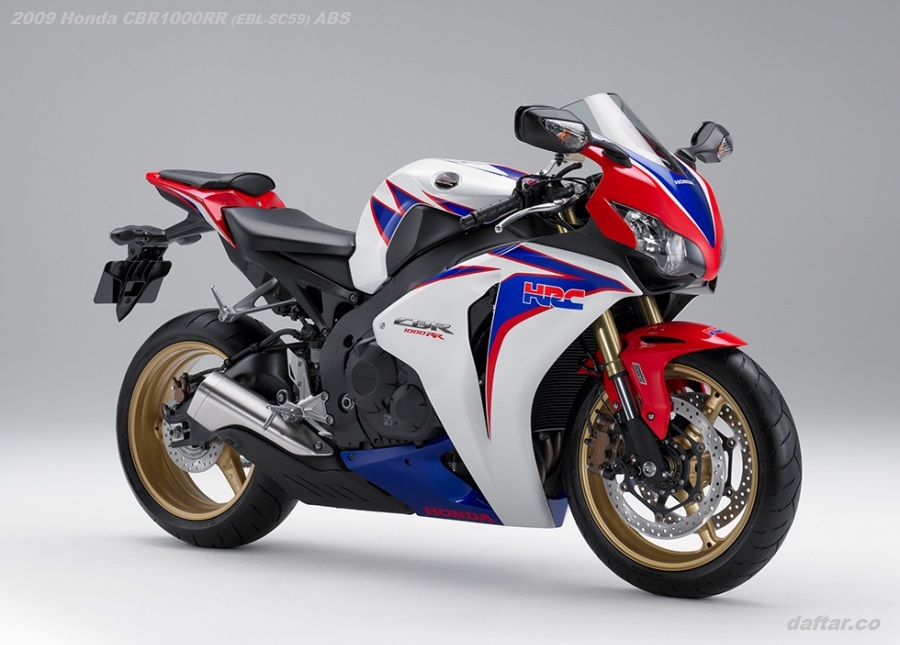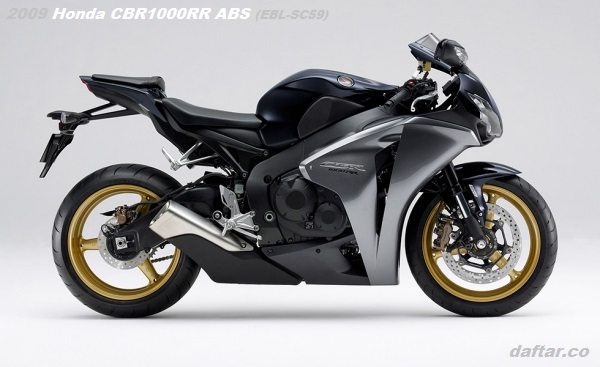2009 Honda CBR1000RR EBL-SC59 ABS equipped with electronically controlled “combined ABS” – Specs, Price, Review
 |
| Honda CBR1000RR (EBL-SC59) ABS wallpaper Release date: 2009-12-10 Color: Pearl Sunbeam White (Tricolor) |
The world’s first electronically controlled “combined ABS” for supersport model is added to the big sports bike “CBR1000RR” equipped with a high-performance water-cooled, 4-stroke, DOHC, in-line 4-cylinder 1000cc engine that achieves both high environmental performance and kinetic performance. CBR1000RR equipped with ABS will be added and released on February 17th (Tuesday) 2009.
The “2009 Honda CBR1000RR ABS” is equipped with the world’s first electronically controlled “combined ABS” developed for supersport models. This system electronically controls both the combined brake system (front/rear wheel interlocking brake system) and ABS (anti-lock braking system), and by controlling them more precisely, it greatly enhances the sense of security when braking. It is raised to. As a special ABS type color, one color, Pearl Siren Blue, which has a high-quality feel, is set for the body color. Bronze color is used for the front and rear brake calipers, and high-quality gold color is used for the front and rear wheels.
With the development keyword of “all the best in super sports”, the CBR1000RR introduces the advanced technology cultivated in the world’s highest peak motorcycle road race “MotoGP”, and makes it easy to handle and powerful at a high level. Along with achieving this, it adopted a novel and stylish design, and was fully remodeled and released in July 2008. Since then, it is a super sports model that has been well received by veteran users who enjoy sports driving. With the addition of the ABS type this time, it is possible to meet the demands of a wider range of sports fans.
This time, the engine of CBR1000RR (including the model equipped with ABS) has a large diameter at the shaft end for the purpose of increasing the inertial mass by about 7% from the conventional model by increasing the diameter of the flywheel and increasing the rigidity of the crankshaft. It has become. This improves throttle control performance in the rotation range, which is often used for sports driving on circuits and driving on winding roads. It is more linear and easy to handle, and achieves high driving performance. On the other hand, the weight of the vehicle is the same as before by adopting a small fan motor and reducing the weight of details such as the sealing bolt of the cylinder head made of aluminum.
In terms of appearance, a new clear lens has been adopted for the tail lamp part, which is equipped with a high-brightness LED lamp with excellent visibility, to give a sharper impression. In addition, a new aluminum cover is installed on the right side of the muffler to improve the texture. A total of three colors are used for the body color. Tricolor with red and blue coloring based on pearl sunbeam white has the “HRC” logo everywhere to further enhance the racing image, and gold-colored front and rear wheels are adopted to give it a strong presence. It is a design. In addition, the coloring that combines graphite black and pearl sunbeam white is equipped with black wheels to give a firm impression. And, in the model with graphite black coloring on the whole body, the main frame and swing arm part unified in silver color emphasize the contrast with the body, and combined with the gold wheel, it is summarized in chic coloring. These three colors are available in both standard and ABS-equipped types, and are available in a wide range of variations.
 |
| Image of Honda CBR1000RR ABS (EBL-SC59) Color: Graphite Black Release date: 2009-02-17. |
The Honda CBR1000RR ABS 2009 has three body colors, the standard colors of Pearl Sunbeam White and Candy Glory Red, which have been popular from the past, plus the tricolor of the racing image. Pearl Siren Blue, which is the exclusive color of CBR1000RR ABS, has been added to make a total of 4 color variations as a series. The rear turn signal has been changed to a sharp and solid design to tighten the rear view.
The CBR1000RR, which was fully remodeled in June 2008, has been redesigned with a novel and stylish design while achieving both ease of use and strength at a high level. As a model that directly responds to the rider’s intentions from touring to circuit driving, it is a model that is especially popular with veteran users. In addition, the CBR1000RR is equipped with the “CBR1000RR ABS” equipped with the electronically controlled “combined ABS” that was developed for the first time in the world for supersport models, and the braking system that is precisely controlled is used during braking. It has gained support as it enhances the sense of security of. The ABS-equipped model has bronze color on the front and rear brake calipers, giving it a luxurious feel.
 |
| Photo of 2010 Honda CBR1000RR ABS EBL-SC59 Tricolor Release date: 2010-12-10 Color: Pearl Spencer Blue. |
2009 Honda CBR1000RR ABS SC59 Price
Planned sales volume (domestic/annual) Series total : 1,300 units
Manufacturer’s suggested retail price
- Honda CBR1000RR standard non-ABS : 1,390,000 yen (main unit price excluding consumption tax 1,323,810 yen)
- Honda New CBR1000RR non-ABS Tricolor : 1,420,000 yen (main unit price excluding consumption tax 1,352,381 yen)
- New Honda CBR1000RR ABS : 1,558,200 yen (main unit price excluding consumption tax 1,484,000 yen)
- New Honda CBR1000RR ABS – Pearl Sunbeam White (Tricolor) : 1,596,000 yen
Features of Honda CBR1000RR SC59 with electronically controlled “combined ABS”
Due to the concept of the vehicle, the super sports model is designed with a short wheelbase and a light vehicle weight, so the vehicle body tends to pitch significantly during sudden braking, and a braking system that can stabilize the behavior of this vehicle body. Development was required. The electronically controlled “combined ABS” mounted on the CBR1000RR ABSelectronically controls both the combined brake system and ABS, and by controlling them more precisely, the sense of security during braking is greatly enhanced. In this system, the ECU (Electronic Control Unit) detects and calculates the input state of the brake, and generates hydraulic pressure by operating the motors in the power units located on the front wheel side and the rear wheel side, respectively, to generate hydraulic pressure for the front wheels. And the optimum braking force is generated for the rear wheels. In addition, by installing a stroke simulator, the lever feeling similar to that of the conventional brake system is realized. Regarding the operation of ABS, in addition to the slip ratio of the front and rear wheels detected by the conventional ABS for sports models, it also detects the input pressure of the brake and enables finer control of the braking force. This electronically controlled “combined ABS” is based on the braking technology that Honda has cultivated over many years, and by further evolving the electronic control technology, it is necessary to maintain the behavior stability of the vehicle body even during sudden braking under various conditions. Achieves precise control of.
- The main CBR1000RR features from the past included.
- Compact form that expresses high performance. The styling is a condensed form that pursues the ultimate athletic performance and centralizes the mass. We have thoroughly pursued aerodynamic performance and realized the aerodynamic design cultivated with the MotoGP machine “RC212V” such as short nose cowling and light rear rotation. By arranging the muffler below, it contributes to the centralization of mass and realizes a slim seat rail. The headlight adopts a line beam variant 2 light type with a unique design. The turn signal with LED position lamp is integrated with the rear-view mirror to add an accent to the design and improve visibility, and also contribute to the improvement of aerodynamic characteristics.
- Newly developed engine that achieves both environmental performance and powerful output characteristics. The engine is thoroughly pursued to be lighter and more compact. In addition to downsizing the cylinder head, we are working to thoroughly reduce the weight of the crankcase, radiator, and other parts. The clutch mechanism uses an assist slipper clutch that suppresses the lock of the rear wheels even when downshifting from high revs. The lever load is reduced and it is easy to handle. Regarding the cleanliness of exhaust gas, in addition to the electronically controlled fuel injection device (PGM-DSFI), a catalyst device (catalyzer) is installed in the exhaust pipe and muffler to comply with the 2007 domestic motorcycle emission regulations.
- Body configuration that realizes agile and nimble handling. Uses a compact 4-split type aluminum die-cast frame that achieves both high rigidity and slimness. It is agile, has excellent responsiveness, and realizes light handling. By adopting a unit pro-link suspension with excellent road followability and a highly rigid inverted type front suspension in the body configuration that aims to centralize the mass, it is easy to handle from urban areas to sports driving, and excellent steering stability is achieved. It has been realized.
Honda CBR1000RR EBL-SC59 ABS Main Specifications
| Common name | CBR1000RR | |
| Vehicle name/model | Honda EBL-SC59 | |
| Overall length x Width x Height (m) | 2.080 x 0.680 x 1.130 | |
| Wheelbase (m) | 1.415 | |
| Minimum ground clearance (m) | 0.130 | |
| Seat height (m) | 0.820 | |
| Vehicle weight (kg) | 201 [211] | |
| Riding capacity (person) | 2 | |
| Fuel consumption rate (km/L) | 24.5 (60km/h constant-land driving test value) | |
| Minimum radius of gyration (m) | 3.3 | |
| Engine model/type | SC59E/Water-cooled 4-stroke DOHC 4-valve 4-cylinder | |
| Total displacement (cm3) | 999 | |
| Inner diameter x stroke (mm) | 76.0 x 55.1 | |
| compression ratio | 12.3 | |
| Maximum output (kW [PS]/rpm) | 87 [118]/9,500 | |
| Maximum torque (N ・ m [kg ・ m]/rpm) | 95 [9.7]/8,250 | |
| Fuel supply device type | Electronic type / Electronic control fuel injection device (PGM-DSFI) | |
| Starting method | Self-type | |
| Ignition system type | Full transistor battery ignition | |
| Lubrication method | Pressure-fed splash combination type | |
| Fuel tank capacity (L) | 17 | |
| Clutch type | Wet multi-plate diaphragm spring | |
| Transmission type | Always meshing 6-stage return | |
| Gear ratio | 1 Speed | 2.285 |
| 2 Speed | 1.631 | |
| 3 Speed | 1.333 | |
| 4 speed | 1.137 | |
| 5 speed | 1.033 | |
| 6 speed | 0.967 | |
| Reduction ratio (1st/2nd) | 1.717/2.562 | |
| Caster (degree)/Trail (mm) | 23 ° 30´/96 | |
| Tire size | Front | 120/70ZR17M/C (58W) |
| Rear | 190/50ZR17M/C (73W) | |
| Brake type | Front | Hydraulic double disc [electronically controlled “combined ABS”] |
| Rear | Hydraulic disc [electronically controlled “combined ABS”] | |
| Suspended method | Front | Telescopic type (inverted type) |
| Rear | Swing arm type (Unit Prolink) | |
| frame format | diamond | |